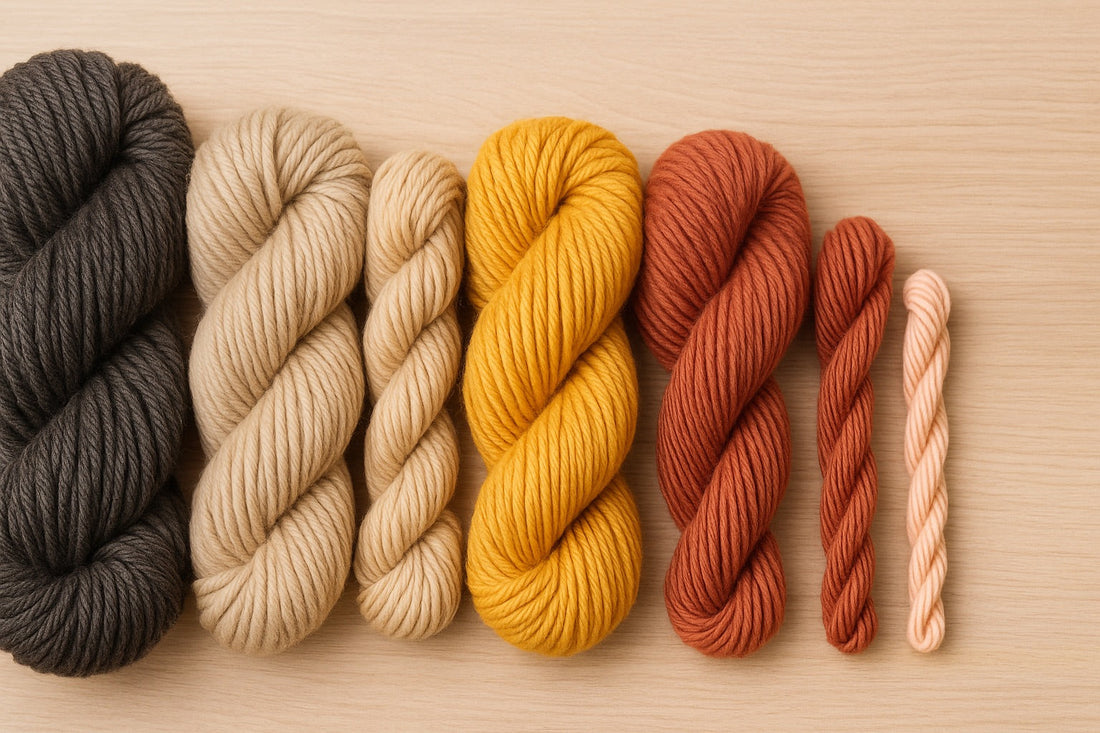
Yarn and skein thickness guide (international standards)
Share
Choosing the right yarn thickness is key to the final result: texture, weight, and size of your project. At Idealium, we follow the international CYC classification (0 to 7) and explain it to you in centimeters , with 10x10 cm swatches and needle and crochet hook ranges. Our goal: for you to choose confidently, without hesitation.
What does the “thickness” of a thread mean?
The weight is the thickness of the yarn and determines how many stitches fit into a 10x10 cm swatch. The thinner the yarn, the more stitches you'll need; the thicker the yarn, the fewer stitches. For example, a Fingering yarn might be around 28–30 stitches/10 cm , while a Bulky yarn might be 12–15 stitches/10 cm . You'll see these references in our weight lists so you can compare at a glance.

International Thickness Table (CYC 0–7)
Note: These are approximate ranges. The sample is calculated using stockinette stitch on two needles. Crochet, for the same thickness, usually results in fewer stitches.| CYC | Name | Also called | Sample (pts/10 cm) | Knitting needles (mm) | Crochet (mm) | Recommended projects |
|---|---|---|---|---|---|---|
| 0 | Lace | Lace, cobweb | ≥33–40 | 1.5–2.25 | 1.25–2.25 | Lace shawls, very light garments |
| 1 | Super Fine | Fingering, Sock, 4-ply | 27–32 | 2.25–3.25 | 2.25–3.5 | Socks, thin tops, small amigurumis |
| 2 | Fine | Sport, 5-ply | 23–26 | 3.25–3.75 | 3–4 | Baby clothes, closed shawls, light garments |
| 3 | Light | DK, 8-ply | 21–24 | 3.75–4.5 | 4–5 | Fine sweaters, jackets, medium-sized amigurumis |
| 4 | Medium | Worsted / Aran* | 16–20 | 4.5–5.5 | 5.5–6.5 | Mid-season sweaters, blankets, accessories |
| 5 | Bulky | Chunky, 12-ply | 12–15 | 5,5–8 | 6,5–9 | Collars, scarves, warm clothing |
| 6 | Super Bulky | Super Chunky | 7–11 | 8–12.75 | 9–15 | XL blankets, baskets, thick jackets |
| 7 | Jumbo | Arm knitting, roving | ≤6 | ≥12.75 | ≥15 | Poufs, rugs, XXL decoration |

How to know the thickness if you don't have a label
If you have a loose ball, you can estimate its size with a centimeter ruler:
- Loosely wrap the thread around a ruler or pencil for 2–3 cm.
- The turns should touch , without overlapping.
- Count how many turns fit in 1 cm (or 2 cm and divide by 2 for more precision).
- Compare it with these reference guidelines :
| Thickness | Turns per cm (approx.) |
|---|---|
| Lace (0) | 7 or more |
| Fingering (1) | 5–6 |
| Sport (2) | ≈ 4.5 |
| DK (3) | ≈ 4 |
| Worsted / Aran (4) | ≈ 3.5 |
| Bulky (5) | ≈ 3 |
| Super Bulky (6) | ≈ 2 |
| Jumbo (7) | 1.5 or less |
Equivalences that often generate doubts
- DK and Light Worsted are very similar; DK is slightly thinner. Check the sample.
- Worsted and Aran share a category (CYC 4); Aran may be a bit thicker.
- “Ply” (4-ply, 8-ply, etc.) is a historical UK/AUS term; today it is used to refer to thickness, not actual number of strands.
- In Europe, we use mm for needles/crochet hooks. Always convert if your pattern is in the US/UK system.
- In crochet , for the same thickness of yarn, hooks that are somewhat larger than knitting needles are used.
How to adapt a pattern to another thickness
- Compare the swatch. If the pattern calls for 20 stitches/10 cm and you get 18, knit tighter or decrease the stitch length by 0.25–0.5 mm (if your project allows).
- Follow the measurements in centimeters. For garments, the important thing is the final size (width, length, girth, etc.), not the number of rows.
- Choose “flexible” projects. Blankets, scarves, and hats tolerate thickness changes better (adjust width/length).
- For amigurumis , look for a tightly woven fabric. If the stuffing peeks through, decrease the crochet hook by half a stitch or adjust the tension.
Frequently Asked Questions
Can I mix weights? Yes, as long as the texture and final tension are consistent. In stripes or colorwork, try to make the yarns sample similarly.
Does the fiber matter? A lot. A stretchy merino wool "fills" more than a cotton wool. That's why the swatch is your best ally.
Ideal thickness to start with? DK (CYC 3) or Worsted/Aran (CYC 4) : the stitches are clearly visible and you progress quickly.
For amigurumis? Between Fingering and DK (CYC 1–3) with a slightly smaller hook to cast off.
Rag yarn and macramé cord? They're equivalent to Bulky-Jumbo (CYC 5-7) ; check the recommended needle/hook size and make a sample.
Shop by thickness
Choose your thickness and start today
SEO
SEO Title: Yarn and Skein Thickness Guide (in cm): Lace, Fingering, DK, Worsted, Bulky, and More
Meta description: Discover international thicknesses (CYC 0–7) in centimeters: equivalencies, 10x10 cm samples and tips for choosing the perfect yarn for your project.

